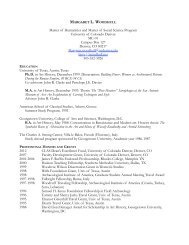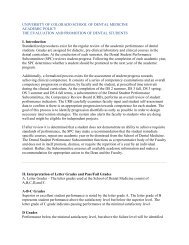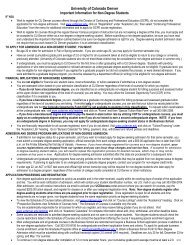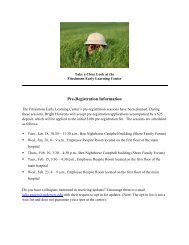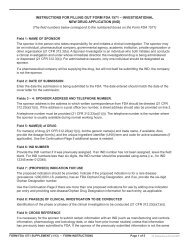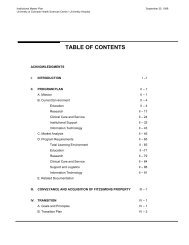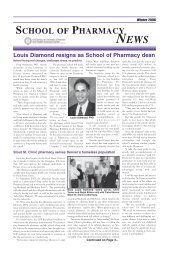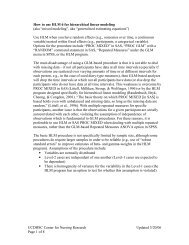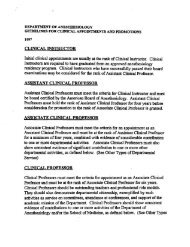Mechanical Ventilation for Dummies
Mechanical Ventilation for Dummies
Mechanical Ventilation for Dummies
You also want an ePaper? Increase the reach of your titles
YUMPU automatically turns print PDFs into web optimized ePapers that Google loves.
<strong>Mechanical</strong> <strong>Ventilation</strong> <strong>for</strong> <strong>Dummies</strong><br />
Keep It Simple Stupid<br />
• Indications<br />
– Airway<br />
– <strong>Ventilation</strong> failure<br />
(CO2)<br />
– Hypoxia<br />
– Combination<br />
• Airway obstruction<br />
• Inability to protect<br />
airway<br />
• Hypoxia (PaO 2 < 50)<br />
• Hypercapnia (PaCO 2<br />
> 50)<br />
• Respiratory distress<br />
(RR > 30, use of<br />
accessory muscles)
Ventilator Management<br />
Scalar<br />
• CMV<br />
• ACV<br />
• IMV<br />
• SIMV<br />
• SIMV + PS<br />
• PCV<br />
• IRV<br />
• PRVC<br />
• APRV<br />
• CPAP<br />
Control Mode- Mode- Mode- Scalars<br />
(Volume- Targeted <strong>Ventilation</strong>)<br />
Preset Peak Peak Peak Flow<br />
Dependent on<br />
C L & L & R aw<br />
Preset V tt<br />
Essentials of of Ventilator Graphics<br />
T im e (s e c )<br />
F lo w<br />
(L/min)<br />
P r e s s u r e<br />
(cm H 2O)<br />
O)<br />
V V o o lu lu m m e<br />
e<br />
(ml)<br />
© 2000 RespiMedu<br />
CLINICAL UTILITY OF VENTILATOR GRAPHICS<br />
Vijay Deshpande, MS, RRT, FAARC
Ventilator Management<br />
Loops<br />
Pressure-Volume Loops<br />
Volume<br />
(mL<br />
mL)<br />
V T<br />
Essentials of of Ventilator Graphics<br />
Expiration<br />
Expiration<br />
Expiration<br />
Expiration<br />
P aw aw<br />
aw (cm aw (cm H 2O) O)<br />
2O) O)<br />
Inspiration<br />
Inspiration<br />
Inspiration<br />
Inspiration<br />
PIP<br />
© 2000 RespiMedu<br />
Flow-Volume Loop<br />
Flow<br />
(L/min)<br />
FRC<br />
4<br />
Essentials of of Ventilator Graphics<br />
1<br />
Inspiration<br />
Expiration<br />
2<br />
3<br />
Volume (ml)<br />
© 2000 RespiMedu<br />
CLINICAL UTILITY OF VENTILATOR GRAPHICS<br />
Vijay Deshpande, MS, RRT, FAARC
Ventilator Management<br />
This really is all there is to it<br />
• Time (RR)<br />
• Volume (Vt)<br />
• Pressure (PIP, P plat )<br />
• Flow<br />
Volume vs Time Scalar<br />
Volume<br />
(ml)<br />
Inspiration<br />
Inspiratory Tidal Volume<br />
TI<br />
Time (sec)<br />
Expiration
Ventilator Management<br />
Control <strong>Mechanical</strong> <strong>Ventilation</strong><br />
• Time – Set respiratory rate<br />
• Volume – Set Vt<br />
• Flow – Set to deliver the Vt<br />
} Independent<br />
Variables<br />
• Airway Pressure – Dependent on the<br />
interaction of the above and on the<br />
respiratory system compliance and airflow<br />
resistance
Ventilator Management<br />
Pressure Control <strong>Ventilation</strong><br />
• Time – Set respiratory rate<br />
• Pressure – Set pressure<br />
• Flow – Set to deliver pressure<br />
} Independent<br />
Variables<br />
• Volume – Dependent on the interaction of<br />
the above and on the respiratory system<br />
compliance and airflow resistance
Ventilator Management<br />
Dual Control Modes - PRVC<br />
• Time – Set RR<br />
• Volume – Set V T<br />
• Flow – Set<br />
} Independent<br />
Variables<br />
• Pressure –increases or decreases to<br />
maintain the set V T (Dependent variable),<br />
but this is Limited (i.e. controlled)
Airway Pressure Release <strong>Ventilation</strong><br />
APRV-BILEVEL<br />
SIMV<br />
CPAP is transiently decreased or<br />
“released” to a lower level during<br />
expiration.<br />
Advantages<br />
1. Lower Paw <strong>for</strong> a given V T<br />
2. Lower V E , i.e., less dead<br />
space<br />
3. Limited adverse effects on<br />
cardiac function<br />
4. Spontaneous breathing<br />
5. Decreased sedation<br />
Potential Disadvantages<br />
1. Volumes change with changes<br />
in compliance and resistance<br />
2. New technology<br />
3. Limited access to technology<br />
4. Limited research and clinical<br />
experience
Ventilator Management<br />
• Peak Insp Pressure (PIP) vs.<br />
• Plateau airway<br />
pressure (P plat)<br />
• Transairway pressure<br />
– PIP-Pplat<br />
• Obstruction<br />
• Secretions<br />
• RAD<br />
P aw<br />
(cm H 2O)<br />
O)<br />
Components of Inflation<br />
Pressure<br />
A<br />
1<br />
Begin Begin Begin Inspiration Begin Expiration<br />
2<br />
B<br />
1. PIP<br />
2. P plat/Alveolar plat plat/Alveolar /Alveolar<br />
plat/Alveolar<br />
Pressure<br />
A. Airway Resistance<br />
B. Distending Pressure<br />
Time (sec)<br />
CLINICAL UTILITY OF VENTILATOR GRAPHICS<br />
Vijay Deshpande, MS, RRT, FAARC
• Compliance<br />
Ventilator Management<br />
– Relationship of<br />
volume to pressure<br />
– Dynamic vs static<br />
Lung Compliance Changes<br />
in the P-V Loop<br />
Volume (mL ( (mL ( mL)<br />
V T<br />
Essentials of of Ventilator Graphics<br />
Volume Targeted <strong>Ventilation</strong><br />
P aw aw<br />
aw (cm aw (cm H 2O)<br />
O)<br />
PIP levels<br />
COMPLIANCE<br />
Normal<br />
Increased<br />
Decreased<br />
© 2000 RespiMedu<br />
CLINICAL UTILITY OF VENTILATOR GRAPHICS<br />
Vijay Deshpande, MS, RRT, FAARC
History of <strong>Mechanical</strong> <strong>Ventilation</strong><br />
• Poliomyelitis<br />
– Negative pressure (iron lung)<br />
• WW II<br />
– Positive pressure cycled (Bennett and Bird)<br />
• Volume cycle (Emerson)<br />
• V T 6-8 ml/kg, Sigh 12-18 ml/kg<br />
• V T 10-15ml/kg without sighs<br />
• ARDS & PEEP<br />
– Ashbaugh Bigelow and Petty UCHSC 1967
Ventilator Induced Lung Injury<br />
VILI is due to volume (Overdistension)<br />
<strong>Ventilation</strong> 45 cm H 2 O<br />
Baseline 5 min 20 min<br />
Dreyfuss Am. Rev. Respir. Dis. 1998; 137: 1159-1164
ARDS is Not Homogeneous<br />
Gattinoni L. Milan Italy
Inflection Points<br />
Paw increases with little change in the volume<br />
Lung Compliance Changes<br />
in the P-V Loop<br />
Volume (mL ( (mL ( mL)<br />
V T<br />
Essentials of of Ventilator Graphics<br />
Lower Upper<br />
Volume Targeted <strong>Ventilation</strong><br />
P aw aw<br />
aw (cm aw (cm H 2O) O)<br />
2O) O)<br />
PIP levels<br />
COMPLIANCE<br />
Normal<br />
Increased<br />
Decreased<br />
© 2000 2000 RespiMedu<br />
Overdistension<br />
P aw rises<br />
aw rises with little or or no change in in V T<br />
P aw<br />
aw<br />
(cm H 2O)<br />
O)<br />
Essentials of of Ventilator Graphics<br />
Pressure (cm H 2O)<br />
O)<br />
© 2000 2000 RespiMedu<br />
CLINICAL UTILITY OF VENTILATOR GRAPHICS<br />
Vijay Deshpande, MS, RRT, FAARC
ARDSnet<br />
NIH NHLBI ARDS Clinical Trials Network
ARDS Network: ARMA<br />
Respiratory Management in ARDS<br />
6 vs. 12 ml/kg Tidal Volume<br />
� Mode: Volume Assist / Control<br />
� Rate: Set rate < 35; adjust <strong>for</strong> pH goal = 7.30-7.45<br />
� Oxygenation<br />
PaO 2 = 55-80 mmHg<br />
SaO 2 = 88-95%<br />
� PEEP 5 5 8 8 10 10 10 .... 20<br />
FiO 2 .3 .4 .4 .5 .5 .6 .7 .... 1.0<br />
� I:E = 1:1.8-1.3<br />
� Weaning by Pressure Support when PEEP/FiO2 < 8/.40<br />
New Eng J Med 2000; 342: 1301
ARDS Network: ARMA<br />
Respiratory Management in ARDS<br />
6 vs. 12 ml/kg Tidal Volume<br />
12 ml/kg Group<br />
• Initial Vt = 12 ml/kg IBW<br />
• If Pplat > 50 cmH20,<br />
reduce Vt by 1 ml/kg.<br />
• Minimum Vt = 4 ml/kg<br />
• If Pplat < 45 cmH20 and<br />
Vt < 11 ml/kg, increase Vt<br />
by 1 ml/kg.<br />
6 ml/kg Group<br />
• Initial Vt = 6 ml/kg IBW.<br />
• If Pplat > 30 cmH20,<br />
reduce Vt by 1 ml/kg.<br />
• Minimum Vt = 4 ml/kg.<br />
• If Pplat < 25 cmH20 and<br />
Vt < 5 ml/kg, increase Vt<br />
by 1 ml/kg.<br />
New Eng J Med 2000; 342: 1301
ARDS Network: ARMA<br />
Respiratory Management in ARDS<br />
6 vs. 12 ml/kg Tidal Volume<br />
cm water<br />
45<br />
40<br />
35<br />
30<br />
25<br />
20<br />
6 ml/kg<br />
12 ml/kg<br />
Plateau Pressure<br />
* * * *<br />
33 + 8<br />
25 + 6<br />
0 1 2 3 4<br />
Study Day<br />
New Eng J Med 2000; 342: 1301
200<br />
180<br />
P/F 160<br />
140<br />
120<br />
ARDS Network: ARMA<br />
Respiratory Management in ARDS<br />
6 vs. 12 ml/kg Tidal Volume<br />
* * *<br />
0 1 2 3 4<br />
Study Day<br />
6 ml/kg<br />
12 ml/kg<br />
PEEP<br />
(cm water)<br />
10<br />
8<br />
6<br />
4<br />
2<br />
0<br />
* *<br />
6 ml/kg<br />
12 ml/kg<br />
0 1 2 3 4 7 14 21<br />
Study Day<br />
New Eng J Med 2000; 342: 1301
ARDS Network: ARMA<br />
Respiratory Management in ARDS<br />
6 vs. 12 ml/kg Tidal Volume<br />
• Vt 6 vs. 12 ml/kg<br />
• Mortality<br />
• 31.0 vs 39.8%<br />
New Eng J Med 2000; 342: 1301
ARDS Network: ALVEOLI<br />
High vs. Low PEEP<br />
• Ventilator management the same as ARMA<br />
except PEEP<br />
Lower – PEEP/ Higher FiO 2 Treatment Group<br />
FiO 2 30 40 40 50 50 60 70 70 70 80 90 90 90 100<br />
PEEP 5 5 8 8 10 10 10 12 14 14 14 16 18 18-24<br />
Higher - PEEP/Lower FiO 2 Treatment Group<br />
FiO 2 30 30 30 30 30 40 40 50 50 50-80 80 90 100 100<br />
PEEP 5 8 10 12 14 14 16 16 18 20 22 22 22 24<br />
N Engl J Med 351:327, July 22, 2004
ARDS Network: ALVEOLI<br />
High vs. Low PEEP<br />
Variable<br />
PEEP<br />
P/F<br />
Low<br />
8.9<br />
168<br />
Day 1<br />
High<br />
14.7<br />
220<br />
Low<br />
8.5<br />
169<br />
Day 3<br />
High<br />
12.9<br />
206<br />
Low<br />
8.4<br />
181<br />
Day 7<br />
High<br />
12.9<br />
218<br />
N Engl J Med 351:327, July 22, 2004
ARDS Network: ALVEOLI<br />
High vs. Low PEEP<br />
Conclusions<br />
•VT goal 6 ml/kg<br />
•Pplat limit of 30 cm<br />
H2O,<br />
•Outcomes are similar<br />
whether lower or<br />
higher PEEP levels are<br />
used.<br />
N Engl J Med 351:327, July 22, 2004
ARDS Network: FACTT<br />
Fluids and Catheter Treatment Trial<br />
PAC vs. CVP<br />
N Engl J Med 354:2213, May 25, 2006
ARDS Network: FACTT<br />
Conservative vs. Liberal Fluid<br />
N Engl J Med 354:2564, June 15, 2006
D<br />
1<br />
2<br />
3<br />
4<br />
5<br />
6<br />
7<br />
ARDS Network: FACTT<br />
Conservative vs. Liberal Fluid<br />
Furosemide mg/d<br />
Liberal<br />
74<br />
72<br />
65<br />
80<br />
73<br />
58<br />
51<br />
Conserve<br />
148<br />
157<br />
166<br />
154<br />
164<br />
158<br />
127<br />
Intake ml/d<br />
Liberal<br />
5029<br />
4467<br />
3997<br />
3752<br />
3825<br />
3782<br />
3639<br />
3430<br />
3201<br />
3159<br />
3226<br />
N Engl J Med 354:2564, June 15, 2006<br />
Conserve<br />
4230<br />
3590<br />
3390<br />
Output ml/d<br />
Liberal<br />
2501<br />
2824<br />
3060<br />
3188<br />
3358<br />
3334<br />
3216<br />
Conserve<br />
3043<br />
3966<br />
3797<br />
3606<br />
3444<br />
3316<br />
3143<br />
Balance ml/d<br />
Liberal<br />
2529<br />
1642<br />
936<br />
563<br />
483<br />
508<br />
458<br />
Conserve<br />
1186<br />
-376<br />
-408<br />
-165<br />
-226<br />
-144<br />
130<br />
7 day fluid balance 6992+502 6992 502 -136 136+491 491
ARDS Network: FACTT<br />
Conservative vs. Liberal Fluid<br />
N Engl J Med 354:2564, June 15, 2006
ARDS Network: FACTT<br />
Conservative vs. Liberal Fluid<br />
Outcome<br />
Death<br />
(60d)<br />
VFD<br />
(28d)<br />
ICU-FD<br />
(28d)<br />
Dialysis<br />
(60d)<br />
Liberal<br />
28.4%<br />
12.1<br />
11.2<br />
14<br />
Conserve<br />
25.5%<br />
14.6<br />
13.4<br />
10<br />
P<br />
0.30<br />
.001<br />
.001<br />
.06<br />
N Engl J Med 354:2564, June 15, 2006
ARDS Network: LASRS<br />
Late ARDS Steroid Rescue Study<br />
Methylprednisolone<br />
•2 mg/kg load<br />
•0.5 mg / kg q 6 <strong>for</strong> 14d,<br />
•0.5 mg / kg q 12 <strong>for</strong> 7d,<br />
•Taper over 4 days<br />
•Taper over a 2 days if<br />
septic shock<br />
•Intensive infection<br />
surveillance<br />
28.6 v 29.2%<br />
New Eng J Med Volume 2006; 354:1671-1684
ARDS Network: LASRS<br />
Late ARDS Steroid Rescue Study<br />
Placebo (91) MP (89) p<br />
Mortality (60d) 28.6% 29.2% 1.0<br />
VFD (28d) 6.8 + 8.5 11.2 + 9.4 .001<br />
ICU FD (28d) 6.2 + 7.8 8.9 + 8.2 .02<br />
Myopathy (no.) 0 9 .001<br />
Infections / pts 43/30 25/20 .14<br />
Amylase (D7) 73 +50 125 + 131 .003<br />
Glucose (D7) 144.0 + 61.8 158.7 + 64.4 .14<br />
New Eng J Med Volume 2006; 354:1671-1684
Institute <strong>for</strong> Healthcare Improvement (IHI)<br />
Ventilator Bundle<br />
• HOB > 30 o<br />
• DVT prophylaxis<br />
• PUD Prophylaxis<br />
• Daily sedative vacation and assessment of<br />
readiness to extubate<br />
http://www.ihi.org/IHI/
<strong>Mechanical</strong> <strong>Ventilation</strong><br />
Weaning<br />
• What was the reason <strong>for</strong> intubation?<br />
• Has that reason been resolved?<br />
• Can patient protect airway?<br />
• Can patient handle secretions?<br />
• Oxygenation?<br />
• <strong>Ventilation</strong>? (CO2)<br />
• Others: Cardiac function, acid base, abdomen,<br />
renal function<br />
• 35% prediction<br />
– “You will never find a fever if you do not measure a<br />
temperature?”
Nonphysicain Directed Weaning<br />
Protocol<br />
Ordered<br />
Ely AmJRCCM 1999; 159: 439 Kollef CCM 1997; 25: 567
Daily Sedative Vacation<br />
Vacation<br />
Control<br />
Kress New Eng J Med 2000
<strong>Mechanical</strong> <strong>Ventilation</strong><br />
Weaning<br />
– Pressure Support<br />
• Gradual reduction in<br />
ventilator work is<br />
assumed by the patient<br />
– SIMV + PS<br />
• Some breaths are<br />
ventilator work and<br />
some are patient work<br />
– T-piece<br />
• Discontinuation of<br />
ventilator work is<br />
assumed by patient.<br />
PSV<br />
Brochard AJRCCM 1994; 150: 896<br />
Esteban NEJM 1995; 332: 345<br />
SBT q d
<strong>Mechanical</strong> <strong>Ventilation</strong><br />
Failure to Wean<br />
• Increase in demands<br />
– Abnormal respiratory mechanics<br />
• RAD<br />
• Decrease C<br />
– Unresolved infection<br />
• Fever = Me = work<br />
• Decrease in patient<br />
capability<br />
– Sedation<br />
– Weakness<br />
• Malnutrition<br />
• Neuro- or Myo-pathy<br />
– Chest wall mechanics<br />
Demands Capability<br />
Total Support<br />
Deleterious<br />
work<br />
Ventilator<br />
Independence<br />
Tolerable load
Weaning Guidelines<br />
• Daily assessment of potential<br />
• Spontaneous breathing trials (30-120 min)<br />
• Stable support between SBTs<br />
• Ability to protect airway<br />
• Reverse causes of failure<br />
• Weaning protocols <strong>for</strong> nonphysician<br />
• Prolonged ventilation=slow gradual<br />
lengthening of SBTs<br />
Chest 2001; 120: 375S
<strong>Mechanical</strong> <strong>Ventilation</strong><br />
Weaning<br />
• Withdrawl of the ventilator<br />
• Test <strong>for</strong> successful extubation<br />
– Vt 5-7 ml/kg<br />
– RR < 30<br />
– Me < 15 L<br />
– RR/Vt < 105<br />
– NIF < 20<br />
– FVC 10-15 ml/kg<br />
10% Failure
Questions?<br />
KISS




